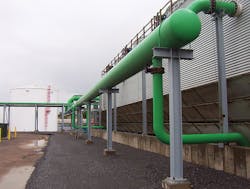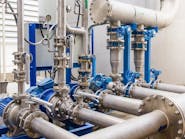Cooling towers scrub large volumes of air and effectively remove solids consisting of dust, microbiological organisms, and various airborne debris. Tower water adds suspended solids in the form of corrosion products, microbiological growths and wood fibers from the tower and process leaks. If allowed to settle, these solids can generate many problems within the system.
With heavy solids loading, even the best treatment program can be severely strained. Under these circumstances, significant improvement might be realized with the use of a side stream filter.
A properly designed side stream filter can benefit your system through:
• Reduced corrosion rates
• Increased equipment life
• Better system efficiency
• Reduced maintenance costs
• Increased chemical efficiency
• Decreased chemical biocide use
With heavy solids loading, significant cooling tower improvement might be realized with the use of a side stream filter.
When to Consider Side Stream Filters
The installation of a side stream filter is a capital expense that generally requires return on investment (ROI) consideration for plants to approve. Consider the following as indications that a plant should evaluate prior to the installation of a filter.
1. The primary make-up is from an unclarified water source (river, sewage treatment, etc.) that is high in suspended solids and/or iron.
2. The system is having a difficult biological problem even though a good biocide program is in effect.
3. Heat exchangers are showing fouling even though a good anti-foulant program is being used.
4. Excessive corrosion rates can be traced to fouling.
5. Loss of heat transfer is attributed to deposition rather than corrosion.
6. High levels of solids are building up in the sump.
7. Heat exchangers require frequent mechanical cleanings.
Benefits of Using Side Stream Filters
Several benefits can result from the use of a side stream filter. Obviously, not all of those listed below apply to all systems, and good judgment must be applied before making any claims. However, bearing that in mind, the following benefits can be realized.
1. Since solids are removed from the system, the corrosion inhibitor will protect clean rather than dirty surfaces, thereby reducing corrosion rates and increasing equipment life.
2. When used with good chemical treatment, the filter will keep the system much cleaner and, as a result, the need for mechanical cleaning of exchangers and sumps is reduced, leading to lower maintenance costs.
3. A cleaner system means better heat-transfer rates for longer periods of time, leading to lower operational costs.
4. In some cases, the removal of suspended solids from the circulating water allows higher cycles, leading to lower membrane exchange and maintenance costs.
5. Large biological growths and dead organisms are removed with a side stream filter. This reduces biocide demand and makes non-oxidizing biocides more effective.
Filter Media
Size of the media is important, since it must:
• Prevent suspended solids from passing through the media.
• Hold solids for easy removal during backwashing.
• Be capable of holding a given quantity of solids without clogging.
Medium size is defined by two figures:
• Effective Size: Particle size above which 90 percent of the medium is larger.
• Uniformity Co-efficient: Effective size divided into the particle size above which 90 percent of the medium is larger.
In most cases, because of their high sediment removal ability, sand or anthracite is the filter medium used, and sometimes the two will be used together (i.e., mixed media). The filter beds contain different size layers of the media. Fine sand or anthracite will be on top, with larger and coarser grades underneath. These will be supported on graded gravel or heavy anthracite.
Most filters operate at a filtration rate of 2 to 3 gallons per minute per square foot of filter surface. Backwash rate is enough to expand the filter bed by 50 percent, usually 10 to 20 gallons per minute per square foot.
Filter media will usually be selected to:
• Remove those particles with the greatest tendency to settle.
• Be least expensive for a given water throughput.
• Require a minimal backwash rate.
Filter Design
It is strongly recommended that a particle analysis be done on the representative stream that is to be treated. This can be reviewed while planning your side stream treatment. For most side stream filtration, a centrifugal style filter is optimal. It will remove the major problems your system faces and require very little maintenance or repair. However, each filter product does have its limitations.
Centrifugal Separators
Centrifugal separators use internal acceleration to separate finer solids. The minimum particle size typically removed is 80 microns. This happens only when the particles are all 1.2 times the density of water or higher. These types of filters are more likely found in a mixed stream where 200 microns can be planned upon. Centrifugal separators have a very small plant footprint, so they can easily be retrofitted to most cooling towers. However, they are not capable of removing organic material or solids that are lighter than water.
Bag Filters
Bag filters can achieve down to 5-micron removal and can remove both inorganic and organic contaminants. Bag filters are more convenient and economical than centrifugal separation or sand media filters, proving to be more cost effective for demanding applications. Bag filters offer the flexibility of adjusting the micron filtration provided when needed (for instance in cottonwood seed time). However, these filters require labor and maintenance time in monitoring and changing out the bags when full.
Cartridge Filters
Like bag filters, cartridge filters can achieve down to 5-micron removal and can remove both inorganic and organic contaminants. The initial expense of these filters is comparable with other filters; however, because cartridges need to be changed out frequently, the ongoing expense is much higher. Cartridge filters offer flexibility of adjusting the micron filtration provided when needed, like bag filters, but with little or no bypass, ensuring the maximum amount of water is treated.
Sand Media Filters
Sand media filters are designed exclusively for the demands of cooling tower operations, achieving down to 5-micron removal performance. Sand media filters are excellent for removing organics but they require a large area of plant space and additional maintenance through media replacement and backflush. While sand filters are the most expensive of all the filters listed, they are proven effective and reliable in cooling tower applications. When set up to backwash on pressure differential, they can handle load variations with manpower. They have the lowest maintenance requirements of all options.
Filter Sizing
Historically, filters were designed to handle approximately 2 percent of the circulating rate. This rule of thumb has proved inadequate for the design of side stream filters in modern industrial plants, and a revised engineering approach is now being used.
If the amount of suspended solids entering the system is constant and known, and the solids desired is also known, and these two conditions are in equilibrium states (little variation of either), the filter size can be determined by the following equation:
Where
F = Filtration rate in gpm
B = Blowdown rate in gpm
Again, this requires a steady-state condition. When the contamination entering a system is erratic because of varying solids entering the system with the make-up (for instance, after a heavy rain) or with the air (for instance, wind shifts changing the dust level in the air), this equation cannot be used.
The following formula for the calculation of filter size assumes that the varying solids loading must be removed from the system in a period of time that is practical yet short enough so that serious deposits will not form. In practice, a 95 percent reduction of a sudden solids load in 1 to 3 days will prevent excessive fouling and allow a filter size that is not prohibitively expensive. The formula used is:
Where
F = Filtration rate in gpm
V = Total system volume in gallons
B = Blowdown rate in gallons per minute
T = Time, by minute
The information on filter design and sizing is provided only as a guide. The specifics are better left to manufacturers of the filtration equipment.
Summary
Side stream filtration is an effective tool for the control of deposition and fouling in a cooling water system. Owing to the capital investment required, its use should be carefully considered. It should not be used as a substitute for good engineering practices, good control, or good operational programs. IWW
U.S. Water helps its customers stay competitive by using its industry experience and expertise to combine chemical, equipment, engineering and service into a customized, integrated water management solution. Focusing on the Future of Water, U.S. Water has a passion for developing and delivering unconventional solutions that leave the world a better place with better water. Learn more at www.uswaterservices.com.
Circle No. 146 on Reader Service Card






